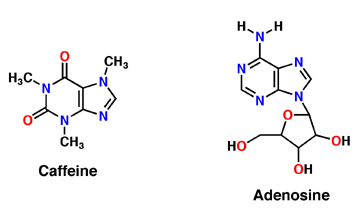Caffeine
From Proteopedia
(Difference between revisions)
| Line 1: | Line 1: | ||
==Caffeine == | ==Caffeine == | ||
<StructureSection load='1stp' size='340' side='right' caption='Caffeine Bound to A2A Receptor' scene=''> | <StructureSection load='1stp' size='340' side='right' caption='Caffeine Bound to A2A Receptor' scene=''> | ||
| - | + | ||
| - | + | <Structure load='4UHR' size='340' frame='true' align='right' caption='Agonist Bound to A2A Receptor' scene='Insert optional scene name here'/> | |
[[Image:Caffeine_and_adenosine.gif]] | [[Image:Caffeine_and_adenosine.gif]] | ||
| Line 17: | Line 17: | ||
== Structural highlights == | == Structural highlights == | ||
| - | |||
| - | <Structure load='4UHR' size='340' frame='true' align='right' caption='Agonist Bound to A2A Receptor' scene='Insert optional scene name here'/> | ||
| - | |||
A2A is a transmembrane G protein in humans. Trimethylxanthine has a highly water soluble and thus when present in the system, interacts with the A2A receptor. In order for Trimethylxantine to bind to the receptor, the third and seventh transmembrane helical domains need to recognize the ligand. Trimethylxanthine can then bind. Trimethylxanthine can bind with very little discomfort, due to its similar structure, as well as its purine alkaloid structure, to adenosine. This binding will change the shape and not initiate the cascade of downstream effects that adenosine does, like opening of ion channels and slowing of activity. Concentrate of free adenosine increases extracellularly, when trimethylxanthine is bound.The cAMP increases when adenosine is bound and (). ERK1 and ERK2 are kinases, composed of serine and threonine, of the GMGC group that regulation of cell growth and differentiation, and if adenosine was bound, this cascade of events would occur, but when Trimethylxanthine is bound, this regulation does not occur. | A2A is a transmembrane G protein in humans. Trimethylxanthine has a highly water soluble and thus when present in the system, interacts with the A2A receptor. In order for Trimethylxantine to bind to the receptor, the third and seventh transmembrane helical domains need to recognize the ligand. Trimethylxanthine can then bind. Trimethylxanthine can bind with very little discomfort, due to its similar structure, as well as its purine alkaloid structure, to adenosine. This binding will change the shape and not initiate the cascade of downstream effects that adenosine does, like opening of ion channels and slowing of activity. Concentrate of free adenosine increases extracellularly, when trimethylxanthine is bound.The cAMP increases when adenosine is bound and (). ERK1 and ERK2 are kinases, composed of serine and threonine, of the GMGC group that regulation of cell growth and differentiation, and if adenosine was bound, this cascade of events would occur, but when Trimethylxanthine is bound, this regulation does not occur. | ||
Revision as of 02:40, 17 November 2015
Caffeine
| |||||||||||
References
Proteopedia Page Contributors and Editors (what is this?)
Mackenzie Kincer, Sidiqullah Halim, Alexander Berchansky, Michal Harel

